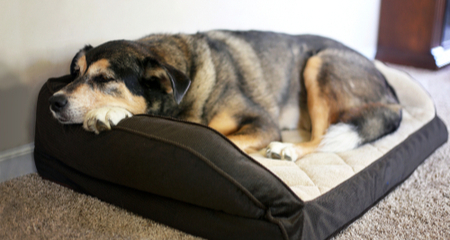Finding the perfect dog bed can be a daunting task, with so many options available in the market. You want to ensure that your furry friend has a comfortable and safe place to rest and sleep. But what should a dog bed really look like? It should provide adequate support for your dog’s joints and muscles, be the right size for your dog to stretch out fully, and be made of durable materials that are easy to clean. Additionally, considering your dog’s sleeping habits and preferences can also help you choose the perfect bed that will keep them cozy and content.
Factors to Consider
When it comes to choosing the perfect dog bed, there are several important factors to consider that can ensure your furry friend’s comfort and happiness. From size and type of bed to material, support and comfort, durability, ease of cleaning, style and design, budget, health considerations, and your dog’s sleeping habits, each aspect plays a crucial role in finding the ideal dog bed for your canine companion.
Size
One of the first factors to consider when choosing a dog bed is the size. Ensuring that the bed matches your dog’s size is essential for their comfort. A bed that is too small can restrict their movement, while a bed that is too large may not provide them with a cozy and secure environment. Taking measurements of your dog and comparing them to the bed dimensions can help in selecting the right size.
It’s also important to consider the growth of your dog. If you have a puppy, you need to choose a bed that will accommodate their anticipated size as they grow. Opting for a slightly larger bed can save you from having to buy multiple beds as your pup matures.
Furthermore, allowing for movement is essential. Dogs often like to stretch out, so a bed that provides ample room for them to lie comfortably in their favorite positions is ideal. Considering your dog’s sleeping habits, such as whether they prefer to curl up or stretch out, can help determine the size of the bed they require.

Type of Bed
There are various types of dog beds available, each catering to different needs and preferences. Understanding the different types can help you make an informed decision based on your dog’s specific requirements.
One of the most common types is the traditional pillow bed, which provides a soft and comfortable surface for your dog to rest on. Another popular option is the crate bed, specifically designed to fit inside a dog crate and provide extra comfort during crate training or while traveling.
For dogs with special needs or joint issues, an orthopedic bed can provide the necessary support and cushioning. These beds are often made with memory foam, which contours to your dog’s body and relieves pressure points.
If you live in a colder climate or have a dog that feels the cold, a heated bed can provide additional warmth and comfort. On the other hand, a raised cot bed can be a great option for dogs who prefer a cooler sleeping surface, as it allows for better airflow.
Donut or bolster beds are ideal for dogs who love to curl up and feel secure, as their raised edges provide a sense of protection and enclosure. Memory foam beds offer luxurious comfort and contouring support, while nesting beds are designed with high sides to create a cozy nest-like environment.
For those who frequently travel with their dogs, a travel bed can offer a portable and comfortable sleeping option. Finally, waterproof beds are a practical choice for dogs prone to accidents or for outdoor use, as they can be easily cleaned and provide protection against moisture.
Material
The choice of material for a dog bed can greatly impact its comfort, durability, and ease of cleaning. Both the fabric and filling materials should be carefully considered.
When it comes to fabric, it’s important to choose a material that is soft, durable, and resistant to wear and tear. Common fabrics used for dog beds include canvas, microfiber, nylon, and polyester. Canvas is a sturdy option that can withstand rough use, while microfiber is known for its softness and resistance to stains. Nylon and polyester are durable materials that offer easy maintenance and cleaning.
The filling material determines the level of cushioning and support. Common options include polyester fiberfill, foam, memory foam, and orthopedic foam. Polyester fiberfill is lightweight and provides basic cushioning, while foam offers more support and resilience. Memory foam and orthopedic foam are often used in beds for senior dogs or those with joint issues, as they mold to the dog’s body shape and relieve pressure points.

Support and Comfort
Ensuring that your dog’s bed provides adequate support and comfort is essential for their overall well-being. Different beds offer various features that contribute to these factors.
Orthopedic support is crucial for dogs with joint problems or conditions such as arthritis. Look for beds that offer extra cushioning and support in the form of memory foam or orthopedic foam.
Temperature regulation is also worth considering, especially if you live in an area with extreme temperatures. Some beds are designed with cooling gel inserts or breathable fabrics that help regulate your dog’s body temperature, keeping them cool in hot weather and warm in colder temperatures.
Cushioning and padding are important for comfort, especially for dogs who spend a significant amount of time in their beds. Beds with thicker padding or those made with memory foam provide a luxurious and comfortable surface for your furry friend to rest upon.
Lastly, consider the pressure points of your dog. Certain beds are specifically designed to alleviate pressure on joints and sensitive areas, such as the hips. These beds often feature raised edges or memory foam that conforms to your dog’s body shape, providing the necessary support and relief.
Durability
A durable dog bed is important to ensure it lasts through your dog’s playful antics and daily use. Pay attention to the following factors to assess the durability of a bed:
Stitching and seam quality should be strong and resistant to unraveling. Reinforced stitching and double-stitched seams can contribute to the longevity of the bed.
Tear resistance is essential if you have a dog who enjoys chewing or scratching. Look for beds made with durable and tear-resistant fabrics that can withstand your dog’s natural instincts.
Chew resistance is particularly important for dogs who tend to gnaw on their beds. Some beds are specifically designed with chew-resistant materials or reinforced stitching to prevent damage caused by chewing.
Lastly, the overall quality of materials used in the bed will determine its durability. Opting for beds made with high-quality fabrics, filling, and construction is a wise investment that will pay off in the long run.

Ease of Cleaning
Keeping your dog’s bed clean and fresh is essential for their health and well-being. Consider the following factors when it comes to the ease of cleaning:
Removable covers make it easier to clean the bed. Being able to remove the covers and throw them in the washing machine can save a lot of time and effort.
Machine washable beds are convenient, especially for larger beds that may not fit in your washing machine. Ensure that the bed is easily washable without losing its shape or quality.
Waterproof materials are ideal for dogs who are prone to accidents or have bladder control issues. These materials prevent moisture from seeping into the bed and can be easily wiped clean.
Odor and stain resistance are desirable features, especially for dogs who spend a lot of time outdoors or have a tendency to get dirty. Beds that repel odors and stains make cleaning and maintenance a breeze.
Style and Design
While functionality is important, the style and design of the dog bed can also enhance your home décor and create a visually pleasing environment. Consider the following aspects when choosing a bed based on style and design:
Color and pattern options can help the bed blend seamlessly with your home décor. Choose colors and patterns that complement your existing furniture and overall aesthetic.
Aesthetics play a role in creating a visually appealing space. Look for beds that have a clean and modern design or those with decorative details that add a touch of style to your home.
Fit with home décor involves considering the size and shape of the bed in relation to your room’s layout. Ensure that the bed fits well in the designated area and doesn’t disrupt the flow of the space.

Budget
Setting a budget is an essential step before embarking on the search for the perfect dog bed. Consider the following factors when deciding on your budget:
Set a budget based on your financial capabilities and what you are comfortable spending on a dog bed. Make sure to consider the long-term investment aspect as well.
Cost vs quality is an important consideration. While there are budget-friendly options available, it’s crucial to balance the price with the quality and durability of the bed. Investing in a higher-priced bed made with better materials may save you money in the long run.
Consider long-term investment when setting your budget. A durable and high-quality bed may initially cost more, but it will likely last longer, saving you from having to replace it frequently.
Health Considerations
Taking into account your dog’s health considerations when choosing a bed can greatly impact their comfort and well-being. Consider the following factors:
Orthopedic beds are ideal for dogs with joint issues, arthritis, or other orthopedic conditions. These beds provide extra support and help alleviate pain and discomfort.
Allergies can affect some dogs, so it’s important to choose a bed made with hypoallergenic materials. Some beds are specifically designed to resist dust mites and other allergens, providing a safer and healthier environment for your dog.
Bed height is another consideration, especially for dogs with mobility issues or elderly dogs. A bed with lower sides or a step-in design can provide easier access for dogs who may have trouble jumping or climbing into higher beds.

Dog’s Sleeping Habits
Understanding your dog’s sleeping habits can help you choose a bed that accommodates their preferences and provides them with the most comfortable sleeping environment. Consider the following factors:
Sleep position plays a role in determining the type of bed your dog may prefer. Whether they prefer to sleep on their side, back, or curled up, there are beds designed to provide optimal support for each sleeping position.
Curling vs stretching is another consideration. Some dogs prefer to curl up in a tight ball, while others enjoy stretching out to their full length. Choosing a bed with enough room to accommodate your dog’s preferred sleeping position is important.
Boxing and nuzzling are habits seen in some dogs who like to use their beds as pillows or snuggle against the sides. Beds with raised edges or bolster beds can provide the perfect environment for this behavior.
Burrowing is a habit often seen in small or toy breeds, where they like to dig and burrow to create a cozy den-like space. Beds with a nesting design, high sides, or those made with plush and soft materials can fulfill this burrowing instinct.
By considering these factors and taking into account your dog’s unique needs and preferences, you can choose a dog bed that provides them with the ultimate comfort, support, and relaxation they deserve. Remember to prioritize their well-being when making your selection, as a good night’s sleep is crucial for maintaining their overall health and happiness.
